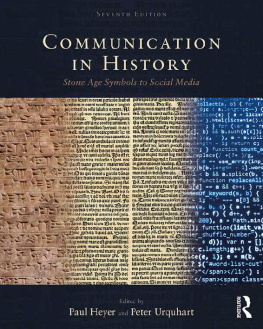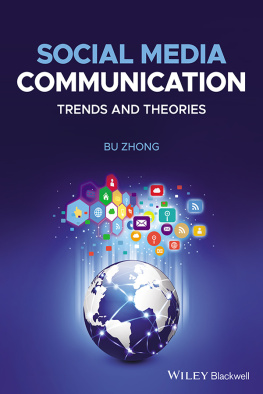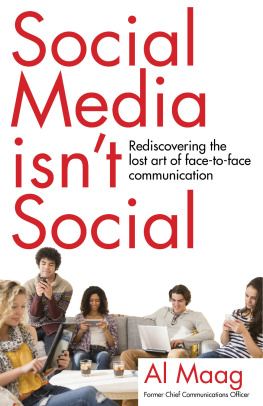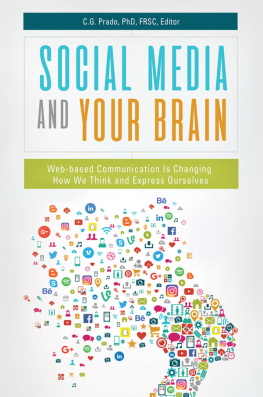Communication in History
Now in its 7th edition, Communication in History reveals how media has been influential in both maintaining social order and as powerful agents of change. Thirty-eight contributions from a wide range of voices offer instructors the opportunity to customize their courses while challenging students to build upon their own knowledge and skill sets. From stone age symbols and early writing to the Internet and social media, readers are introduced to an expansive, intellectually enlivening study of the relationship between human history and communication media. This new edition features an expanded discussion of communications in the digital age, as well as the latest international scholarship on literacy, printing, and sound technologies.
Paul Heyer is Professor Emeritus in the Communication Studies Department at Wilfrid Laurier University, Canada.
Peter Urquhart is Associate Professor in the Communication Studies Department at Wilfrid Laurier University, Canada.
Communication in History
Stone Age Symbols to Social Media
SEVENTH EDITION
Edited by
Paul Heyer and Peter Urquhart
First published 2019
by Routledge
711 Third Avenue, New York, NY 10017
and by Routledge
2 Park Square, Milton Park, Abingdon, Oxon, OX14 4RN
Routledge is an imprint of the Taylor & Francis Group, an informa business
2019 Taylor & Francis
The right of the editors to be identified as the authors of the editorial material, and of the authors for their individual chapters, has been asserted in accordance with sections 77 and 78 of the Copyright, Designs and Patents Act 1988.
All rights reserved. No part of this book may be reprinted or reproduced or utilised in any form or by any electronic, mechanical, or other means, now known or hereafter invented, including photocopying and recording, or in any information storage or retrieval system, without permission in writing from the publishers.
Trademark notice: Product or corporate names may be trademarks or registered trademarks, and are used only for identification and explanation without intent to infringe.
Library of Congress Cataloging-in-Publication Data
Names: Heyer, Paul, 1946 editor. | Urquhart, Peter, 1967 editor.
Title: Communication in history : media, culture, society / [edited by] Paul Heyer,
Peter Urquhart.
Description: Seventh edition. | New York : Routledge, 2018.
Identifiers: LCCN 2018011689
Subjects: LCSH: CommunicationHistory. | Mass mediaHistory.
Classification: LCC P90 .C62945 2018 | DDC 302.209dc23
LC record available at https://lccn.loc.gov/2018011689
ISBN: 978-1-138-72947-6 (hbk)
ISBN: 978-1-138-72948-3 (pbk)
ISBN: 978-1-315-18984-0 (ebk)
Typeset in Minion Pro
by Apex CoVantage, LLC
Contents
Denise Schmandt-Besserat
Harold Innis
Marcia Ascher and Robert Ascher
Andrew Robinson
Eric Havelock
Robert K. Logan
Walter Ong
James Burke and Robert Ornstein
Thomas F. Carter
Lewis Mumford
Harvey J. Graff
Mitchell Stephens
James W. Carey
Michael Schudson
Claude S. Fischer
Rosalynd Williams
Stephen Kern
Ulrich Keller
Lisa Gitelman
Jonathan Sterne
Daniel Czitrom
Scott Eyman
John Durham Peters
Susan J. Douglas
Christopher Sterling and John M. Kittross
Paul Heyer
Michele Hilmes
Peter Fornatale and Joshua E. Mills
William Boddy
Edmund Carpenter
Lynn Spigel
Gary Edgarton
Richard Butsch
Lev Manovich
Janet Abbate
Jay David Bolter and Richard Grusin
Alice E. Marwick
Tom Standage
Guide
The historiography of communication is undergoing its second important shift. Students of contemporary media and culture are increasingly interested in the long-term environment of human experience that frames modern communication, and that interest is reshaping the study of history in the field. This anthology, with its particular structure, is a crucial and long overdue contribution to that reformulation.
For much of its initial life, communication history was the story of the press, typically rendered as the biographies of great publishers or newspapers or of other specific media institutions and major figures, as in the chronicles of particular networks, media moguls, or film genres. The best such work, although generally in the minority, tended to situate its narratives in a broader social context, examining, for instance, the relationship between the press and changing forms of democracy, between film and socio-cultural experience, or between the electronic media and political economic patterns. The first significant shift in communication historiography was to make such broader considerations of politics, law, economics, and culture much more regular, intimate elements, to weave their threads more tightly into the tapestries of particular journalism and media histories.
If that first major shift was to broaden the horizontal frame of reference, to situate media history in a wider range of social institutions, the second major shift is to extend the frame vertically, to consider the broader story of media institutions against a much deeper chronological backdrop of the whole of human history, to examine the role of communication in the development of the human species and its forms of civilization.
It is in light of that latter shift that this book should be considered. The editors take their clue from the pioneering work of such scholars as Walter Ong, Elizabeth Eisenstein, and Harold Innis. Those communication historians share a keen interest in the deep civilization context of all principal forms of communication technologies, thereby encouraging a much richer understanding of the present, rapidly changing experience.
There are several key principles of this school of communication historiography that are well reflected in this book. First, this approach perceives all contemporary media and communication technologies as extensions of basic, innate human communication capacities. It refuses to abstract contemporary forms of media hardware and uses television cameras, personal computers, and satellites, seeing them instead as part of a long, complex process by which human beings are continuing to work out their particularly strong skills and instincts for creating systems of meaning and symbolic interaction. In this light, modern media technologies are only the latest, albeit highly significant, forms of ancient human communication technologies that include speech, gesture, drama, and social ritual of all kinds.
Second, as those different technologies have variously held sway during different periods of human experience, they have had differential impact on the defining characteristics of the capacities of the species. It appears that the very cognitive structure of the individual human being and the formal patterns of human social relations are intimately linked to the forms or systems of communication that are predominant in given eras. An oral culture, without writing, print, or electronic media, seems to be biased toward a particular pattern of sensory and expository capacity that encourages ways of seeing, hearing, and, indeed, knowing that are remarkably different when other forms of communication are more prominent. Over time those tendencies seem in turn to favor and encourage major changes in social organization, influencing, if not defining, choices among options in political, legal, religious, and economic structures. The whole of human experience, therefore, seems to depend greatly upon the form or forms of communication that are most in ascendancy during any era.









